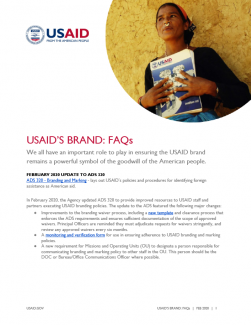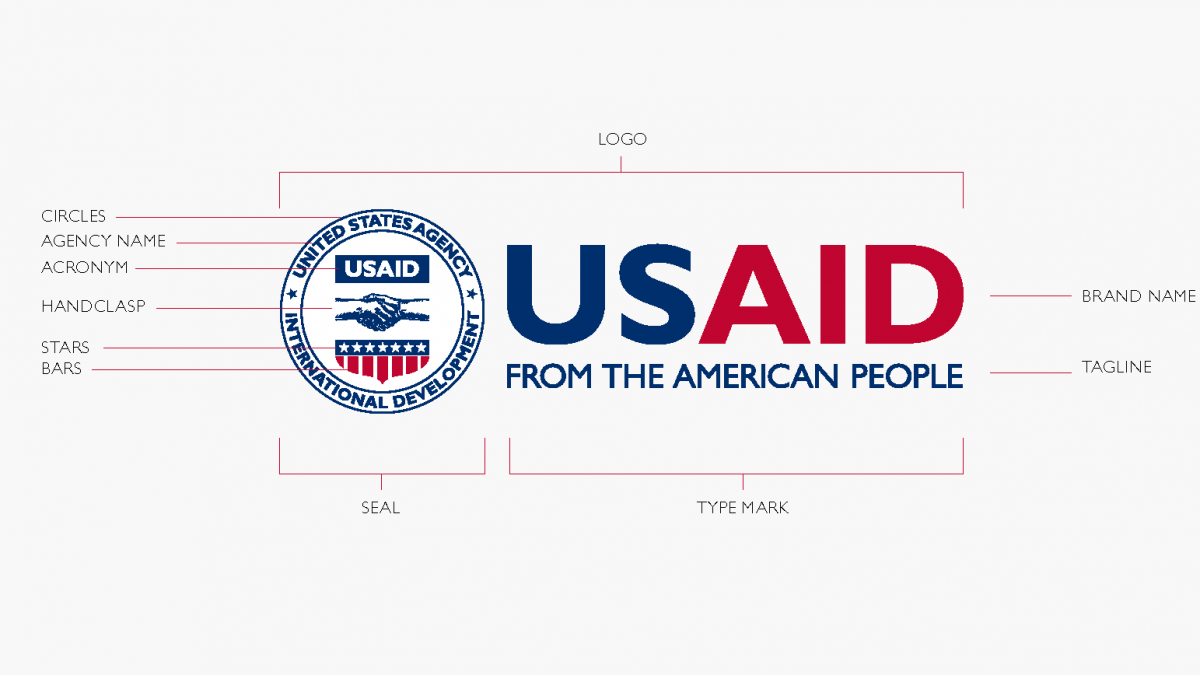We all have an important role to play in ensuring the USAID brand remains a powerful symbol of the goodwill of the American people.
FEBRUARY 2020 UPDATE TO ADS 320
ADS 320 - Branding and Marking - lays out USAID’s policies and procedures for identifying foreign assistance as American aid.
In February 2020, the Agency updated ADS 320 to provide improved resources to USAID staff and partners executing USAID branding policies. The update to the ADS featured the following major changes:
- Improvements to the branding waiver process, including a new template and clearance process that enforces the ADS requirements and ensures sufficient documentation of the scope of approved waivers. Principal Officers are reminded they must adjudicate requests for waivers stringently, and review any approved waivers every six months.
- A monitoring and verification form for use in ensuring adherence to USAID branding and marking policies.
- A new requirement for Missions and Operating Units (OU) to designate a person responsible for communicating branding and marking policy to other staff in the OU. This person should be the DOC or Bureau/Office Communications Officer where possible.
BRANDING HELP
WHERE CAN I FIND BRANDING INFORMATION?
You’ll find answers to the most common questions below. Also see the useful references and resources posted on our branding page www.usaid.gov/branding .
I STILL NEED HELP. WHO SHOULD I CONTACT?
The COR or AOR is your first stop if you are a partner and have a basic branding concern or seek clearance for branding on your product. The bureau communicator or DOC is your first stop if you are internal to USAID.
PURPOSE OF USAID BRANDING
WHY DO WE BRAND?
We brand because Federal law and related USAID regulations require that USAID-funded projects are identified overseas as “American Aid.” That’s why USAID policy requires marking aid with USAID’s logo, including the tagline “From the American People.” Branding enhances the visibility and value of U.S. assistance while transparently informing beneficiaries of the source of that aid.
WHAT HAPPENS IF I DON’T BRAND?
Failure to brand violates U.S. law and USAID policy, regulations, and guidance, creates audit vulnerability, and perhaps most importantly, deprives beneficiaries of U.S. Government foreign aid programs from understanding the source of the assistance and deprives U.S. taxpayers and USAID from receiving credit for the important work that USAID performs across the globe. To brand is to further the U.S. Government’s foreign assistance and public diplomacy goals.
HOW CAN I MONITOR PARTNER COMPLIANCE WITH USAID’S BRANDING AND MARKING POLICY?
You’ll find a new Monitoring and Verification Form under “Additional Help Documents” in ADS 320.
FUNDING + BRANDING
WHAT DOES FUNDING HAVE TO DO WITH BRANDING?
- Branding follows funding, i.e. depends on the type of program funding mechanism.
- Projects which are solely funded by USAID, such as acquisition instruments (contracts, purchase orders, BPAs, task orders, etc.) or USAID corporate communications, shall be exclusively branded in accordance with the policies and procedures as laid out in 2 CFR 700 and ADS 320.
- Projects which are co-funded by USAID and other partners, such as assistance instruments (grants, cooperative agreements, etc.) or partnerships are co-branded by the partners.
DO I HAVE TO PUT USAID’S LOGO ON MY USAID-FUNDED COMMUNICATION?
- If your project is solely funded by USAID, under an acquisition instrument or a corporate product, the answer is yes. USAID gets:
- Exclusive branding. USAID’s logo shall be the only logo displayed on the product; it will be prominently displayed on the front. See USAID’s Graphic Standards Manual, USAID-branded examples in sections 2 and 3.
- If your project is co-funded or funded under an assistance instrument, the answer is yes. USAID gets:
- Co-branding. USAID’s logo shall be displayed at visually equal size and prominence as each of the other partners’ logos. See USAID’s Graphic Standards Manual, co-branded examples in section 4.
WHEN DO WE CO-BRAND?
- With the interagency
- With partner country governments
- With Public International Organizations
- With Public-Private Partnerships
- With any assistance instrument
See ADS 320.3.3.2, ADS 320.5.1 and ADS 320.3.5 for more information.
WHERE CAN I FIND THE CURRENT EDITION OF USAID’S GRAPHICS STANDARDS MANUAL AND PARTNER CO-BRANDING GUIDE?
You’ll find the current edition at www.usaid.gov/branding. The manual went through significant updates in 2016 that include streamlined guidance, new options and new sections on modern media.
INTERNAL COMMUNICATIONS
DO I NEED TO BRAND MY INTERNAL COMMUNICATIONS (E.G., A FLYER THAT I AM HANGING UP IN THE RONALD REAGAN BUILDING)?
If it is a USAID event, yes. You should brand internal communications appropriately as branding helps identify us as an Agency and helps us speak with one voice. All communications, internal and external, should be branded. Flyers for the RRB only should be cleared by your bureau communicator. They should not be sent to Agency branding champions.
LOGOS AND SUB-BRANDS
ARE THERE ANY OTHER REQUIREMENTS ABOUT USING USAID’S LOGO?
- Do not alter USAID’s logo.
- Minimum size: See USAID’s Graphic Standards Manual, section 1.3
- Clear space: See USAID’s Graphic Standards Manual, section 1.3
- Color background: See USAID’s Graphic Standards Manual, sections 1.3 and 1.4
WHERE CAN I GET THE USAID LOGO FILES?
www.usaid.gov/branding/resources
MAY I CREATE A LOGO FOR MY PROJECT?
- If your project is funded under an acquisition instrument or is a corporate product, the answer is no.
- If your project is funded under an assistance instrument, the answer may be yes. Logos are only allowed, in rare cases, for cooperative agreements and grants that require a unified identity in order to achieve the program objectives. There must be a plan in place for how the new brand would live beyond USAID assistance. Per ADS 320, LPA/Senior Advisor for Brand Management must clear on the creation of a project logo.
- If your project is an internal initiative, the answer is no.
MAY MY BUREAU OR OFFICE CREATE A LOGO?
No. USAID bureaus, offices, and any other sub-sets may not create a logo.
- You may not create USAID sub-brands for projects, bureaus, or offices.
- The only sub-brands allowed are Country and Regional Missions. Contact USAID’s branding champions brandingchampions@usaid.gov to request a new or revised sub-brand for your mission.
MAY I CREATE A USAID SUB-BRAND FOR MY PROJECT, BUREAU, OFFICE, OR MISSION?
- You may not create USAID sub-brands for projects, bureaus, or offices.
- The only sub-brands allowed are Country and Regional Missions. Contact USAID’s branding champions brandingchampions@usaid.gov to request a new or revised sub-brand for your mission.
LOOK AND FEEL
DO BRANDED MATERIALS HAVE TO LOOK AND FEEL A CERTAIN WAY?
Yes, our branded materials also have to have a certain look and feel. This includes the use of certain fonts and certain colors. For these specifications, please see USAID’s Graphic Standards Manual sections 1.4 and 1.5.
MUST I USE USAID’S APPROVED FONTS?
- If your project is funded under an acquisition instrument or is a corporate product, the answer is yes. See USAID’s Graphic Standards Manual, sections 1.5, 2.1 and 3.1.
- If your project is funded under an assistance instrument, the answer is no.
- See USAID’s Graphic Standards Manual, section 1.5, for more information on fonts.
MUST I USE USAID’S APPROVED COLORS?
- If your project is funded under an acquisition instrument or is a corporate product, the answer is yes. See USAID’s Graphic Standards Manual, sections 1.4, 2.1 and 3.1.
- If your project is funded under an assistance instrument, the answer is no.
- See USAID’s Graphic Standards Manual, section 1.4, for more information.
CLEARANCE
WHO CLEARS ON BRANDING?
- For USAID internal communications: Your bureau communicator or DOC clears.
- For contract-funded projects: Your COR clears in consultation with the DOC or bureau communicator.
- For assistance-funded projects: Your AOR clears in consultation with the DOC or bureau communicator.
- USAID branding champions brandingchampions@usaid.gov clear on high-profile external communications, waivers, project logos, and more complex matters.
- For waivers: The Principal Officer must consult with the responsible Bureau/Office AA, cognizant Regional Legal Officer (RLO) or the Office of the General Counsel (GC), and the cognizant CO/AO and must seek clearance from the Senior Advisor for Brand Management (or designee) in the Bureau for Legislative and Public Affairs on waiver requests. All waiver requests must follow the Marking Waiver Action Memo template found in ADS 320.
UPDATING PROJECT MATERIALS
DO I NEED TO DISCARD EXISTING PROJECT MATERIALS WHICH DO NOT FOLLOW USAID’S GRAPHIC STANDARDS?
No. Existing products which follow USAID’s previous graphic standards may be used until stock is exhausted. See USAID’s Graphic Standards Manual, section 1.3.
I WOULD LIKE TO UPDATE MY CURRENT PROJECT WITH THE NEW GRAPHIC STANDARDS. DO I NEED TO GET APPROVAL FROM ANYONE?
You should work closely with your USAID CO/AO and COR/AOR to make updates based on the graphic standards manual.
IF THERE ARE COST IMPLICATIONS FOR ME FOLLOWING THE NEW GRAPHIC STANDARDS, ARE THESE COSTS APPROVED?
You should connect with your USAID CO/AO and COR/AOR to discuss any costs related to making updates based on the graphic standards manual. If you have a previously approved approach, do not make any changes without the approval of your USAID project CO/COR or AO/AOR.
RESOURCES
WHERE CAN I FIND MORE INFORMATION AND THE RELEVANT DOCUMENTS?
See www.usaid.gov/branding and www.usaid.gov/branding/resources


